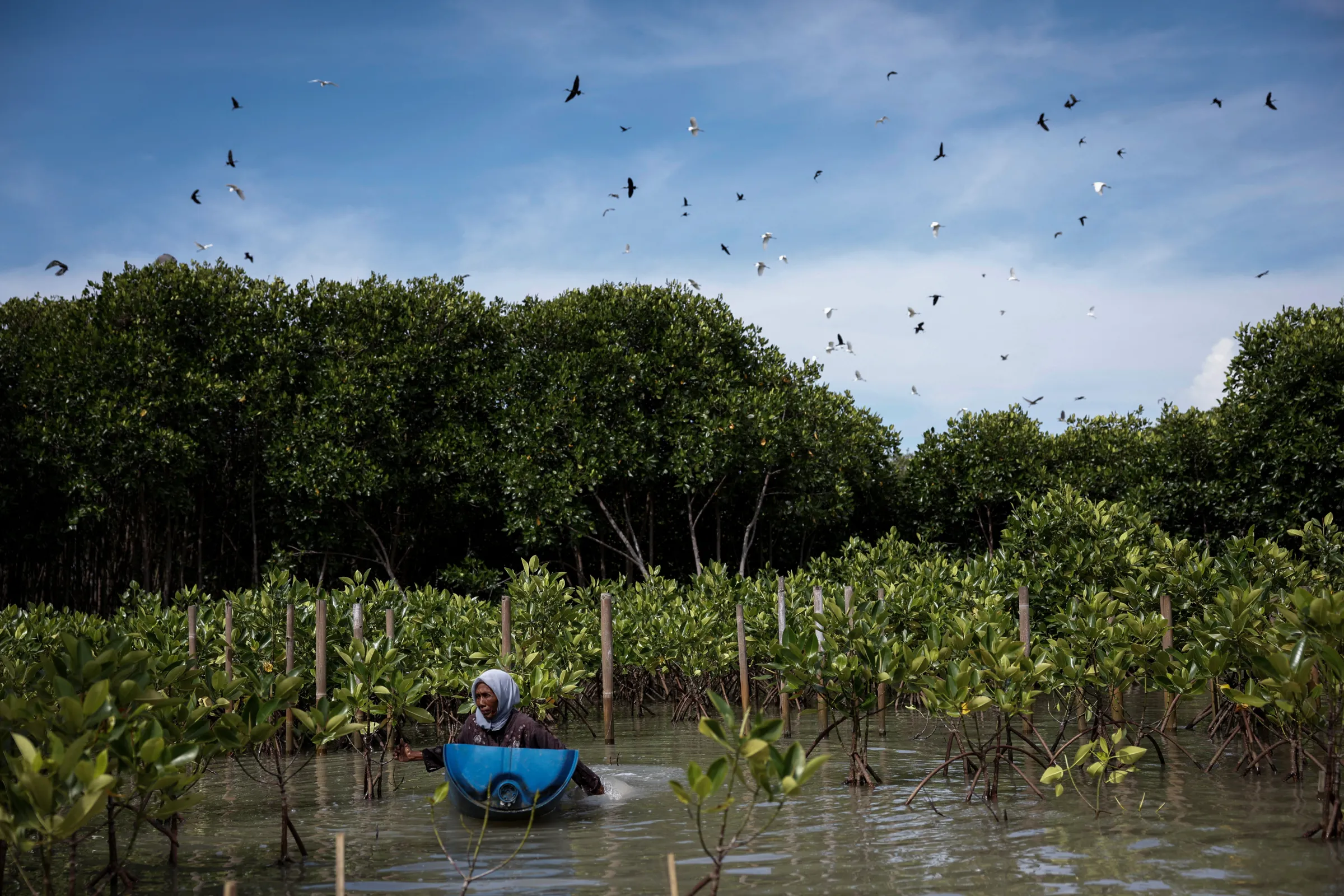The 'Mother of Mangroves' on saving the Philippines' coastline

A woman checks mangrove seedlings after they were planted in the hamlet of Rejosari Senik, Demak regency, Central Java Province, Indonesia, February 19, 2025.REUTERS/Ajeng Dinar Ulfiana
What’s the context?
As aquaculture drives loss of Philippine mangroves, renowned ecologist says political will key to mangrove rehabilitation.
MANILA - The Philippines has touted aquaculture for decades to secure food as wild fisheries stocks decline, but the vast coastline farms have themselves been a significant driver of mangrove loss and degradation.
Jurgenne Primavera, an internationally recognised marine scientist from the Zoological Society of London, worked in aquaculture development until she discovered its impact on mangroves and moved into conservation in the 1970s.
Since then, the marine scientist, now 78, has earned the moniker "Mother of Mangroves" after decades of studying and protecting mangroves across the country.
She spoke with Context to discuss how the Philippines and the region can stem loss and protect biodiversity.
How did you get into mangrove conservation?
I did shrimp culture research in the Philippines for 37 years, so that’s farming shrimp and making them spawn and mature. We had a brackish water pond station, and whenever I go to the ponds I would notice in the margins some strange looking trees. Then I realized the fish ponds came from them.
I discovered that they were cut down so we can have the shrimp ponds. And the more I read, the more I discovered the negative impacts of aquaculture on mangroves, which was touted to be the saviour of the world in terms of food production.
My first scientific papers were purely on aquaculture, on how to spawn shrimps, until my research shifted. It became more critical of shrimp culture. Because basically, I am an ecologist.
How important are mangroves to disaster-prone countries like the Philippines?
If you look at the data on storm occurrences all over the globe, about a third of all storms occurred in the Philippines. Those factors make us so vulnerable to climate-related disasters.
We need the mangroves for storm protection, especially with climate change and the increasing intensity of storms and as (a) barrier from sea level rise.
Among all the different forests, mangroves are the most efficient in capturing carbon dioxide.
Fisheries within the mangroves like clams and shells sustain fishing communities, while offshore fisheries depend on mangroves as nurseries for several fish species, such as mangrove snapper.
What are the biggest challenges to mangrove rehabilitation in the Philippines?
In 2008, I did a paper with an environmental economist which looked at how we can get the maximum value of mangroves' goods and services if a mangrove area is converted to other uses.
We found that if you keep 80% of a given mangrove area as is, and we clear or convert only 20% into, say, a fishpond, then you can get the value of aquaculture but still retain the value of storm protection and fisheries.
The 4:1 ratio of mangroves to ponds was supposed to guide our policymakers. But when we look at the current ratio, it's 1:1.
Over the decades, the Philippines has tried two ways of increasing our mangrove cover: seafront planting and sea grass planting. [They] were not effective.
What should be done is the reversion of abandoned and unproductive fish ponds to mangroves by the Bureau of Fisheries, who manages them.
Our existing mangroves are being threatened by development, such as coastal road or seawall projects and land reclamation.
In areas with mangroves, [the government] would install sea walls for disaster risk reduction, without thinking that the greenbelt of mangroves is already the best defence against storms.
Despite the many challenges in restoring Philippine mangroves, were there any successes in conservation in recent years?
We have seen political will in local governments, like in Siargao, which I think is one of the major success stories because the mayor is enlightened [about mangrove conservation]. But on a smaller scale, we now have mangrove ecoparks in various areas, such as in Aklan province which protected their centuries-old and highly diverse mangroves.
In Leganes, Iloilo, 15 hectares (37 acres) of abandoned ponds belonging to the municipal government have been converted into mangroves. It was an effort of different groups, from schools to communities, the private sector, government employees and even religious groups.
This interview has been edited for length and clarity.
(Reporting by Mariejo Ramos. Editing by Jack Graham and Ellen Wulfhorst)
Context is powered by the Thomson Reuters Foundation Newsroom.
Our Standards: Thomson Reuters Trust Principles
Tags
- Adaptation
- Forests
- Biodiversity

















